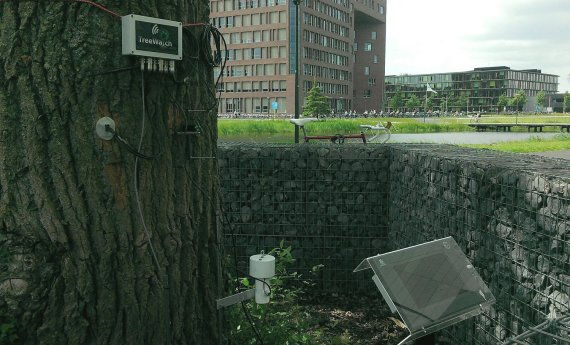Photo: Roelof Kleis‘Good morning; my sap flow just got going’ could well be one of the tweets that the poplar will share with the world. The 30-year-old tree could also tell you how many litres of water it transpired by the end of the day via its Twitter account: @TreeWatchWUR. All this is made possible by sensors in the tree and technology that converts the measured data into text messages.
Twittering Tree
Project leader Ute Sass-Klaassen’s (Forest Ecology and Forest Management) enthusiasm about the Twittering Tree is simply contagious. The tree is the latest technology in public awareness within her field. At least: it is the latest tech in the Netherlands, as the system has already been active for years in Belgium and Germany. The twittering tree is an invention of the Belgian Professor Kathy Steppe and her team at the Ghent University. In Belgium, the equipment has been hooked up on a beech, a maple and an oak. The tree twittering in Germany is a Scots pine.
The twittering tree is a gimmick, Sass-Klaassen admits, meant to introduce the broader public to the tree-related research that is done in Wageningen. ‘We want to show people what is happening inside a tree. What consequences does a warm and windy day like today have on the transpiration? At which point during the year does a tree start growing and how fast does that happen? A lot of things are going on inside a tree.’ The interested public will share in the information via daily tweets.
There is a lot of serious science behind this gimmick.
Ute Sass-Klaassen
A sap flow meter and a dendrometer take centre stage in the information flow. The first measures the speed at which water is transported within the tree. The latter measures the changes in the thickness of the tree. This thickness changes through growth over time, but there are also changes that are measurable by day. The tree shrinks during the day whenever it transpires a lot of water and its reserves run low, and it significantly swells up again when it sucks up water during the night to refill its reserves. A climate station (for air humidity and temperature) and a soil moisture sensor complete the whole.
Growth ring
But you should not get the impression that the setup is purely for show. ‘There is a lot of serious science behind this gimmick’, says Sass-Klaassen. ‘The measurements are used to itemise the physiological reactions of the tree to the environmental factors. The great thing is, each tree already documents these environmental factors: everyone knows about growth rings. The width or a growth ring provides information on the general growth conditions of the tree. But we take it a step further and look at the size of cells within a growth ring.’
In fact, the form and dimensions of the cells in each growth ring tell a story about the environmental factors during the growth of the tree. In times of drought, smaller cells are formed, Sass-Klaassen explains. ‘This means it is possible to extract information about the climate from the size of the cells, as well as the tree’s reaction to it. Each tree is an archive, but a key is necessary to be able to decode the information.’ The twittering tree helps in finding this key. It provides a continuous flow of data on growth, use of water and transpiration. Data that can feed models which predict how trees will react to climate change.
On 30th of May there will be a WURTalk on the Twittering Tree.

